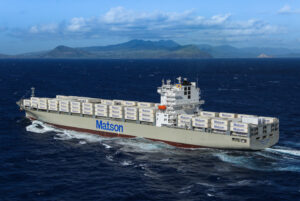U.S. shipowner Matson has wrapped up the conversion of its third containership to run on liquefied natural gas (LNG) as part of the long-term strategy to reduce greenhouse gas (GHG) emissions.
The
U.S. shipowner Matson has wrapped up the conversion of its third containership to run on liquefied natural gas (LNG) as part of the long-term strategy to reduce greenhouse gas (GHG) emissions.

Namely, the 2019-built containership Kaimana Hila was retrofitted with an LNG dual-fuel gas supply system in accordance with a contract Matson had signed with Chinese shipbuilder COSCO Shipping Shipyard (Nantong) in February 2024.
As per the contract terms, the 3,600 TEU containership was equipped with LNG dual-fuel gas supply and control systems for both the main engine and four auxiliary engines.
Related Article
-
 Posted: 10 months ago
Posted: 10 months ago
The ship’s engine was converted from a MAN B&W S90ME-C10.5 unit to a dual-fuel ME-GI unit capable of running on LNG. MAN PrimeServ, the after-sales division of MAN Energy Solutions (ES), executed the retrofit.
Following the conversion and with the addition of the new bow windshield for improved aerodynamics and fuel conservation, Kaimana Hila returned to service, Matson informed on December 12, 2024.
Kaimana Hila is Matson’s third vessel to operate on LNG, joining its sister ships, Daniel K. Inouye and Manukai.
These conversions are said to be part of the shipowner’s long-term strategy to reduce Scope 1 fleet GHG emissions by 40% by 2030 and achieve net zero emissions by 2050.
Apart from retrofitted ships, Matson also has three LNG-ready Alhoa Class containership newbuilds on order at compatriot Philly Shipyard.
The first unit, Makua, is under construction and scheduled for delivery in 2026.
All three new vessels will be delivered sometime during 2027, representing a $1 billion investment for Matson. The newbuilds will be Jones Act-compliant, with a carrying capacity of 3,600 TEU and speeds exceeding 23 knots, engineered for Matson’s Hawaii and China-Long Beach Express (CLX) services.
As disclosed, the new vessels will be equipped with dual-fuel engines, capable of running on both conventional marine fuels and LNG, as well as other ‘green ship technology’, such as a fuel-efficient hull design, double hull fuel tanks, and freshwater ballast systems.
Related Article
-
 Posted: 2 months ago
Posted: 2 months ago
Content Original Link:
" target="_blank">


























































